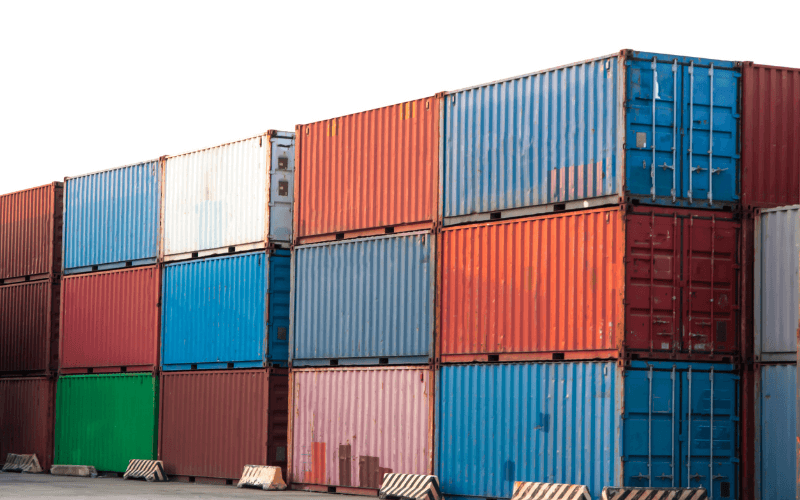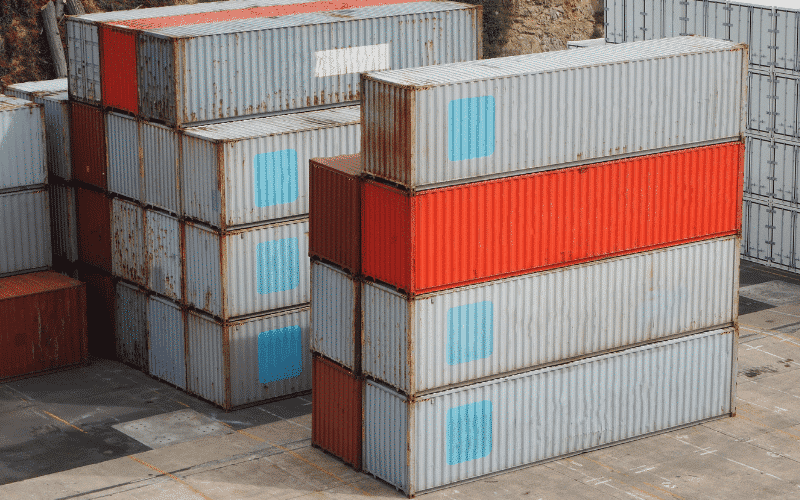
[ad_1]

Containerization is hailed as one of the greatest innovations in the goods transportation industry. Ever since the American entrepreneur Malcolm Maclean came up with the first container made of corrugated steel in 1955, the container has evolved from the humble corrugated steel box to the present-day super-efficient intermodal container.
Such containers can be transported by ships or over the land on trucks or railways.
Intermodal containers are heavy-duty boxes of standard sizes made of Corten steel – a special steel alloy that can withstand corrosion and other harsh elements of nature. Shipping containers, as they are commonly called, can be safely locked and sealed using special container seals for transport by sea or land.
Intermodal containers come in standard sizes of 20’, 40’, and 45’ and therefore can be handled by standard container handling equipment such as cranes or heavy-duty lifts. A standard 20’ container can carry about 28200 KG in weight or roughly 33 CBM. A 40’ container can hold 28800 KG weight of goods or about 67 CBM. The 45’ high cube container has a lesser weight carrying capacity of 27600 KG while it can take about 85 CBM in volume.
Containerized goods can be transported overland by standard trucks with trailer beds. Special temperature-controllable containers called refrigerated containers or reefers are used extensively to transport items that are temperature sensitive.
While containerization is no doubt very useful for the transportation of goods between different locations by different modes of transport, they do have some disadvantages. Let us take a look here at some of the main advantages and disadvantages of containerization.

Advantages of Containerization
Flexibility
Containers can transport a very large variety of goods ranging from food grains or food products to machinery. Out-of-Gauge cargo (OOG) can be easily transported on flatbeds or platform containers. Cargoes that are of abnormal sizes and shapes that do not fit into the normal containers are called OOG cargo.
Specially constructed containers called Reefers (Refrigerated Containers) can carry those items that are sensitive to temperature variations such as pharmaceutical drugs and perishable food items.
Typically, it consists of an insulated container fitted with a portable refrigeration unit. The temperature inside a refrigerated container can be set according to the requirements of the item that it carries.
A flexitank is a sturdy container with a large, durable, and flexible bag inside that can be filled with any non-hazardous liquid cargo for transport. Flexitanks are used to transport certain liquid cargo in bulk such as wines, latex, edible oils, etc.
Ease of Management
Management of container cargo or FCL (Full Container Load) is easier than handling other methods of transporting goods such as by Less-than Container Loads (LCL).
Shipping containers are indivisible units and each registered container has a unique identification number making it easy to track and trace it during a voyage. This unique number called the container number is given to it following specifications of the Bureau International des Containers (BIC). The BIC is an organization based in Paris that ‘oversees standards for intermodal containers’.
The container number is used in the verification of cargo by various parties such as the shipper, the receiver, ports and customs authorities, etc.
Speed of Transportation
With bigger and more powerful cargo ships and modern container handling equipment, transhipment times have reduced drastically. Loading and unloading are faster these days, at ports as well as at modern warehouses.
Standardized MHE (Material Handling Equipment) makes it easier to handle shipping containers coming from and going to different parts of the world.
Economies of Scale
The cost of transporting goods by containers is said to be 20 to 25 times less than the cost of transporting the same goods as loose bulk or LCL. Containerization has drastically brought down the transport cost element in the pricing of goods.
Economies of scale is a major factor here. In general, economies of scale is the advantage companies get as a result of producing or dealing in bulk.
Durability
Depending on the usage, a shipping container can last for 10 to 25 years. Once they are condemned after it is no longer usable, containers are often used for storage or converted as living quarters.
Empty containers are used as temporary storage space by warehouses and distributers especially when their storage facility has reached its capacity. Containers can be placed in any convenient location in the warehouse yard. It provides temporary and flexible storage for companies when required.
The practice of refurbishing and using old containers as living quarters is gaining popularity the world over. It is inexpensive to set up while at the same time they look stylish when done properly and aesthetically.
Safety and Security
Intermodal containers are safe and secure. These heavy-duty boxes are walled on all five sides except one end where the double doors are located. These double doors have double lock-rods each, that are used to lock and seal the container making it safe and tamper-proof.
Standardization
Since ISO-certified containers are of standard size and dimensions they can be handled universally by any standard transport and MHE. This makes it easier to use, transport, and store the containers.

Disadvantages of Containerization
Space Constraints
Containers, whether carrying cargo or empty, take up a lot of space. Terminals need to have enough stacking space to accommodate containers that come in and go out of it. Containers that must go out first must not be at the bottom of a stack.
To put this into perspective, the largest container ship today – HMM Algeciras, can carry about 24,000 TEU. Large container ships need more draft or depth, with the above ship taking up close to 55 feet!
The latest container handling equipment and other infrastructure have to be in place to ensure minimum port turnaround times for cargo ships. Besides a favourable location, a container terminal needs to take all these into consideration.
Infrastructure Costs
The latest dockside gantry cranes and other terminal equipment cost several million US dollars. Leading ports and terminals are those that can make these investments and also keep the equipment upgraded according to advances in technology.
While developed nations can make such investments others may find it difficult to keep up with the race.
Container Management Failure
Management of containerized cargo depends on timely receipt and processing of information. An effective terminal management software ensures effective management of all the information that is necessary for the successful running of a terminal. Cutting corners here can have disastrous consequences.
Re-positioning of Empty Containers
Containers that come in with cargo are unloaded and eventually moved to the designated stack for empty containers at their destination. Shipping companies need their empty containers to be available where there is demand. Hence, empties (empty containers) have to be relocated in a timely manner to the desired locations.
We must remember that a container whether full or empty requires the same space, both at storage, as well during transhipment. Unless empty containers are moved out of empty container yards to destinations where they can be put to use, it would result in demand-supply imbalance leading to a shortage of containers for shipments.
Large sums of money are spent by shipping companies to reposition their empty containers.
Smuggling
Smuggling of contraband such as arms, drugs, and even human trafficking happens through containers. Typically, customs authorities the world over inspect containers at random. It is possible that contraband can sometimes slip through.
Other reasons that prompt the authorities to inspect certain containers are tip-offs, irregular documentation, suspicious patterns of shipping goods, etc.
Customs in developed countries use X-ray scanners that can scan containers.
Notwithstanding drawbacks, experts have forecasted a growth rate of 3 – 4% for containerized cargo in the next three years. This comes as welcome news for the cargo shipping industry after the beating it took in the last year due to the Coronavirus pandemic.
You might also like to read:
- How to Plan Cargo Containers Stowage on Container Ship?
- How Are Shipping Containers Made?
- What is Stuffing and Destuffing of Shipping Containers?
- Understanding the CSC Plate Of Shipping Containers
- Flat Rack Containers: Types, Specifications And Dimensions
Disclaimer: The authors’ views expressed in this article do not necessarily reflect the views of Marine Insight. Data and charts, if used, in the article have been sourced from available information and have not been authenticated by any statutory authority. The author and Marine Insight do not claim it to be accurate nor accept any responsibility for the same. The views constitute only the opinions and do not constitute any guidelines or recommendations on any course of action to be followed by the reader.
The article or images cannot be reproduced, copied, shared or used in any form without the permission of the author and Marine Insight.
Advantage and Disadvantages of Containerization appeared first on Marine Insight – The Maritime Industry Guide
[ad_2]
This article has been posted as is from Source